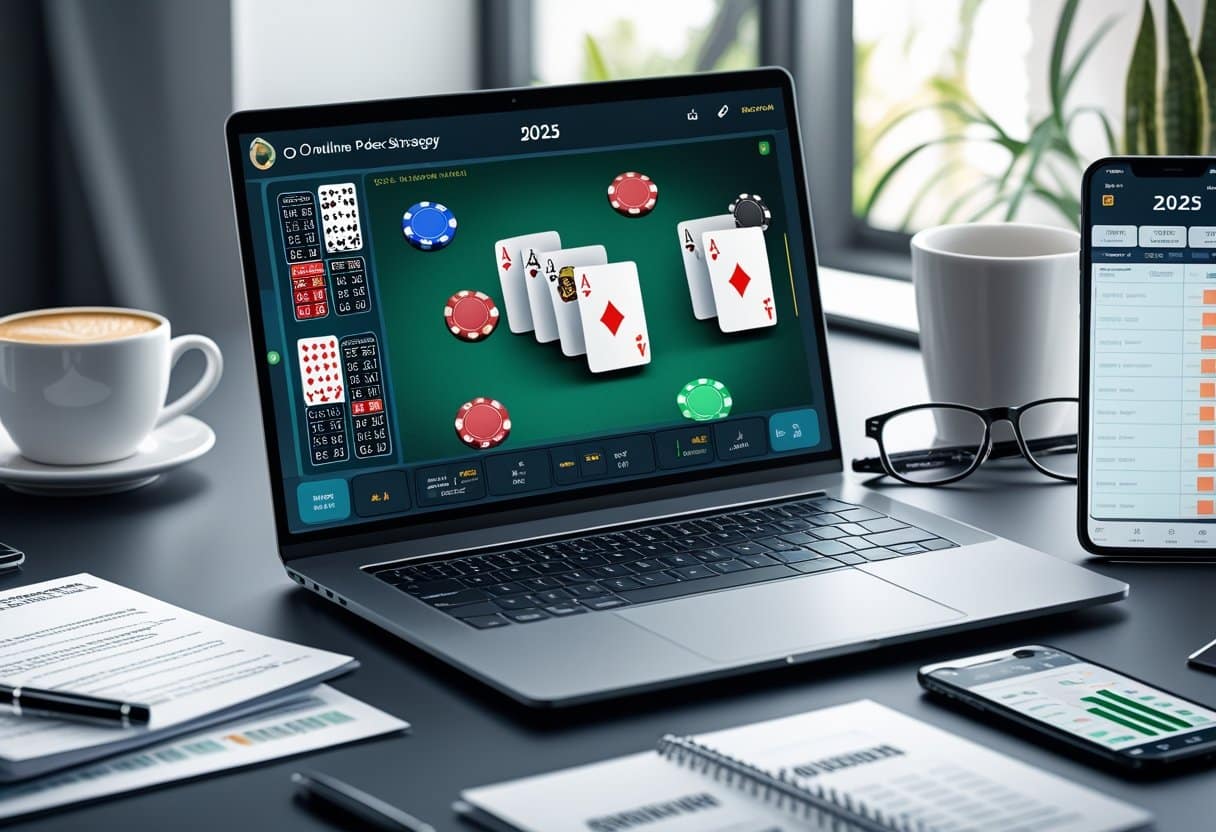Online poker just keeps changing, doesn’t it? Yet, some strategies still hold strong, even as 2025 rolls around.
A lot of players get stuck trying to keep up, not sure which tactics are still worth their time. The reassuring part? There are a handful of tried-and-true methods that keep delivering results—even as everything else seems to shift.

Honestly, if you want to beat online poker at lower stakes, sticking to a TAG (tight and aggressive) style, picking the right tables, and managing your bankroll is still the way to go. This works because, let’s face it, most folks at these levels are making mistakes you can pounce on—no need to get lost in GTO charts.
Even the big names—think Daniel Negreanu—are still making it work by playing lots of smaller pots and steering clear of wild risks. That keeps opponents guessing and cuts down on nasty swings.
So, whether you’re brand new or just trying to get better, these time-tested strategies are still your best bet for an edge at the virtual tables in 2025.
Fundamental Online Poker Strategies for 2025

The poker world keeps shifting, but some core approaches just keep working. It’s about math, reading people, and really zeroing in on the mistakes other players make.
Understanding Value Betting
Value betting is still the bread and butter of winning poker in 2025. It’s all about betting when you’re pretty sure your hand is ahead of what your opponent will call with.
Getting the bet size right is crucial. Go too big, and everyone folds; go too small, and you’re just leaving money out there.
A handy rule? Bet about 50-75% of the pot with strong hands on good boards. That hits the sweet spot more often than not.
Plenty of players still botch their value betting frequencies. If you figure you’ve got the best hand 60% of the time or more, that’s your green light to bet for value.
People often get way too passive with strong hands. If you’ve got top pair and a solid kicker, you should probably be betting or raising, not hiding behind a check or call.
Adapting to Modern Player Pools
Player pools online have changed a lot. The average skill level’s gone up, but there’s still money to be made if you’re paying attention.
Use tracking software to study how people play. You’ll spot patterns you’d never catch just watching the action.
Table selection? Still matters—a lot. Spend 15-20 minutes hunting for tables with a couple of recreational players before you even sit down.
When you play matters, too. Weekends and evenings are still softer, while weekday mornings can be a grind against tougher competition.
Change your approach depending on who’s at your table. Against tight-aggressive regulars, play it a bit safer. But when you’ve got loose, passive players, open up your value betting range and go after them.
Exploiting Bad Players and Fish
Finding and beating up on weaker players—let’s call them fish—is still the fastest way to rack up profits in 2025. They keep making the same mistakes, and you can just keep scooping up the chips.
Spot the ones who limp in a lot, call every raise, and chase draws they really have no business chasing. Those are your targets.
When you’re up against fish, keep it simple. Bet your strong hands for value, don’t bother bluffing too much, and be willing to call their bluffs with decent hands.
Position is huge against these players. If you can sit to their left, you get to isolate them and play more pots against them.
Forget fancy moves. Recreational players aren’t folding to triple-barrel bluffs—they want to see cards. Just bet your good hands and let them pay you off.
Game Selection and Bankroll Management
Winning at online poker isn’t just about how you play your cards. Picking the right games and managing your bankroll are the real foundation for long-term success.
Choosing the Right Poker Games
Game selection is, honestly, half the battle. Look for games with weaker players—these are usually at lower stakes like NL2 or NL5.
You’ll find more recreational players making basic mistakes there. Cash games, in particular, are a solid choice for most folks since you can jump in and out and build your bankroll steadily.
If you see a table full of tight-aggressive regulars, just move on. You want tables where people are limping in, calling too much, and chasing draws with no clue about the odds.
Once you’ve got the basics down, mid stakes (NL50-NL200) can be a nice balance of action and skill level.
Managing Wagering Requirements
A healthy bankroll is your safety net during the inevitable rough patches. Most pros swear by having 20-30 buy-ins for whatever cash game you’re playing.
So, for NL5 ($0.02/$0.05) with a 100BB buy-in, you’ll want at least $100-$150 stashed away. It might seem cautious, but it keeps you in the game when things go sideways.
Don’t jump up in stakes just because you’re feeling lucky. Wait until you’ve got the bankroll and a proven track record at your current level.
Keep good records of your play. There are plenty of tracking apps that’ll help you spot leaks and see how you’re really doing over thousands of hands.
Maximizing Fair and Fast Payouts
Pick poker sites that pay out quickly and reliably. Bitcoin’s made things a lot easier—same-day withdrawals with no fees are pretty standard now.
How fast you can get your money matters. Quick payouts give you more options and flexibility.
Stick to sites that process withdrawals within hours, not days. No one likes waiting around for their own money.
Steer clear of platforms with high withdrawal fees or endless paperwork. Those little hassles can eat into your profits over time.
Before you go all-in with a site, test their withdrawal system with a small cashout. It’s worth the peace of mind.
Mastering Advanced Online Poker Techniques
If you want to really stand out, you’ll need some advanced tricks up your sleeve. The pros are always looking for ways to make better decisions, manage multiple games, and use stats to their advantage.
Multi-Tabling for Profit
Multi-tabling—playing at several tables at once—can seriously boost your hourly rate. Most sites let you open anywhere from four to two dozen tables, depending on where you play.
Start slow, maybe two or three tables, and ramp up as you get comfortable. Arrange your tables so you can see everything without getting lost.
Tools like table trackers and auto-seating help keep things organized. Some folks even use two monitors to keep all the action in view.
The trick is to stay focused and disciplined. Use hotkeys for routine actions, and don’t try to get fancy—play a straightforward style when multi-tabling.
VPIP and PFR: Key Stats for Success
VPIP (Voluntarily Put Money In Pot) and PFR (Pre-Flop Raise) are two stats you’ll want to know. They show how often a player gets involved and how aggressively they play.
A solid TAG player usually has a VPIP around 19-23% and a PFR between 17-21%. That tight gap means you’re playing strong hands and not just calling everything.
Tracking software displays these stats on your opponents, making it easier to spot the fish. If you see someone with a VPIP over 30%, they’re probably playing too many hands.
Aggression Factor (AF) is another stat worth watching—it tells you how often someone bets or raises versus checking or calling. Most winning players keep an AF above 2.5.
Adjusting to Bad Beats and Variance
Bad beats are just part of poker. Even the best get crushed by a two-outer sometimes. The key is not letting the swings mess with your head.
Focus on making the right decisions, not just the results. If you played a hand well but lost, you’re still on the right track.
Bankroll management is your shield during losing streaks. Having 20-30 buy-ins for your stake helps you weather the storm.
When things go south, take a break. Walk around, meditate, whatever helps you reset. It’s better than tilting off your stack.
Keep a record of your sessions. Over time, you’ll see what’s just variance and what might be a real leak in your game.
Maximizing Online Poker Bonuses and Promotions
Poker sites throw out all kinds of bonuses to get you in the door. The trick is knowing which ones are actually worth your time and how to clear them without taking on extra risk.
Evaluating Fair Bonuses
A good bonus doesn’t tie you up with impossible terms. Look for ones with low wagering requirements—10x or less is ideal. Sites are getting more competitive about this in 2025.
Always skim the fine print. Some bonuses look great but give you barely any time to clear them. Thirty to sixty days is reasonable for most.
Bigger isn’t always better. A $50 bonus with 5x playthrough can be way easier to unlock than a $200 bonus with 25x requirements.
Some sites pay out bonuses in chunks as you earn points. That’s usually better for casual players who aren’t grinding all day.
Unlocking Bonus Rewards Efficiently
Pick games that count fully toward clearing your bonus. Cash games usually count 100%, while tournaments might not.
Use the site’s tools or your own spreadsheet to track your progress. It’s easy to lose sight of deadlines otherwise.
Stick to stakes you’re comfortable with when clearing bonuses. It’s not worth risking your whole bankroll just to get a few extra bucks.
A few solid bonus-clearing tips:
- Play more tables at once—four to six is a sweet spot for most
- Try faster formats like Zoom or Rush poker
- Play during peak hours when tables are full and hands come quickly
Reload bonuses can be better value than welcome offers, since they usually have lower requirements. Keep an eye on promo calendars for these deals.
Improving Your Poker Skills for 2025
If you want to keep winning, you’ve got to keep learning. The best players never stop tweaking their game and picking up new tricks.
Utilizing Online Poker Training Platforms
Poker training sites have gotten really good in 2025. Tools like PokerSnowie let you practice against smart AI opponents and get instant feedback on your mistakes.
Video libraries with pros breaking down hands are everywhere now, and a lot of them offer step-by-step courses that take you from beginner to advanced.
Training communities are a great place to swap ideas and review hands. Sometimes, an outside perspective is exactly what you need.
Set aside a couple hours a week for focused training. Track your stats—VPIP and PFR are a good start—to see if you’re actually improving.
Developing Optimal Hand Ranges
Hand selection is still the backbone of winning poker. TAG style is going strong, especially at the lower stakes.
Here’s a quick breakdown by position:
- Early position: Play about 10-15% of hands—mostly big pairs and strong broadways
- Middle position: Open up to 15-20% of hands
- Late position: You can get up to 25-35% of hands here
Work on your 3-bet and 4-bet ranges, too. Mixing in some bluffs with your value hands keeps opponents guessing.
Range visualization tools are super helpful. They show you how different hands stack up against what your opponent might have.
Try to think in terms of ranges, not just specific hands. It leads to more consistent, less emotional decisions.
Leveraging Poker Cheat Sheets and Tools
Poker cheat sheets are a lifesaver when you’re learning. The best ones in 2025 cover:
- Preflop hand charts for each position
- Pot odds calculators so you can make quick, solid calls
- Push/fold charts for those short-stack spots
Modern HUDs (Heads-Up Displays) still work on many sites and give you real-time info on your opponents. That’s a huge edge if you use it right.
Equity calculators help you see your winning chances in any spot. Being able to estimate equity in your head is a skill worth having for fast-paced games.
Remember, these tools are there to help—not to do all the work. The best players use them as a guide, not a crutch.
Exploring Game Variants and Mobile Experience
Poker’s not just about Texas Hold’em anymore. There are more ways to play than ever, and mobile platforms are finally catching up in terms of speed and security.
Popular Variants: Omaha, Video Poker, and More
Omaha Hold’em is still gaining fans in 2025. With four hole cards, there’s a lot more action and a lot more to think about.
Video poker is a nice hybrid if you want something between slots and poker. Jacks or Better is still the go-to for its simple paytable and easy rules.
Progressive jackpot poker games are exploding. Prize pools just keep growing until someone hits the big one—some have even topped $1 million this year.
If you’re after something classic, Seven-Card Stud and Five-Card Draw are still kicking around. Sometimes, it’s nice to step away from community cards and play something old-school.
Best Mobile Online Poker Platforms
These days, top poker sites really do a solid job of optimizing their platforms for mobile play. You don’t have to give up features just because you’re on your phone.
Modern poker apps? They usually come with handy stuff like multi-table play, quick-seat buttons, and even gesture controls that actually work.
Key features to look for in mobile poker platforms:
- Stability during peak hours
- Quick hand transitions
- Easy-to-use betting sliders
- Seamless table switching
Battery optimization has gotten a lot better lately, so you can play longer sessions without your phone dying halfway through. Some platforms even toss in special power-saving modes just for poker.
User interfaces are way more intuitive now, with layouts you can tweak to your liking. Want different card designs, table colors, or bet sizing buttons? You can probably make those changes in just a few taps.
Security Measures and Safe Gambling Practices
Most reputable poker sites take security pretty seriously these days. Two-factor authentication? That’s become the norm, so you’ll need both your password and a verification code every time you log in.
Financial transactions are locked down with encryption technology. Always check for SSL (Secure Socket Layer) encryption—if a site doesn’t have it, I’d honestly look elsewhere.
Responsible gambling tools are everywhere now, and that’s a good thing. You’ll see deposit limits, time notifications, self-exclusion choices, and those reality check reminders popping up.
RNG (Random Number Generator) certification is another must-have for fair play. Independent auditors like eCOGRA or iTech Labs step in to make sure the games aren’t rigged.
Geolocation tech quietly checks you’re playing from a legal region. It’s all in the background, so you probably won’t even notice it’s there.













